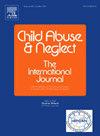Adverse childhood experiences screening in healthcare settings: A focus on pediatric primary care
IF 3.4
2区 心理学
Q1 FAMILY STUDIES
引用次数: 0
Abstract
Background
Adverse Childhood Experiences (ACEs) screening in healthcare settings is emerging as one of the tangible responses to address the consistent evidence linking ACEs with health. Kaiser Permanente Southern California (KPSC) began ACEs screening in pediatric primary care in 2018 and has developed screening and referral processes based on continued feedback from stakeholders as well as data driven assessment.
Objective
We give an overview of the state of ACEs screening in pediatric healthcare settings, challenges facing pediatric providers, and suggestions to address them. We then describe the development of our ACEs screening and referral process within KPSC as an example of how a large healthcare system has implemented and adapted ACEs screening from pilot testing, to phased expansion, to complete implementation.
Participants and setting
Children aged 2–18 years old who were members of KPSC 2018–2023.
Results
We present data on the tailored screening and referral workflows we have developed, rates of positive screens and referrals, and how the initiation of ACEs screening may affect the rates of visit to behavioral health as a treatment option. We also integrate qualitative data to demonstrate the perspective of parents, with the goal of understanding what might help or hinder receipt of behavioral health treatment after ACEs screening.
Conclusions
We close with future directions for ACEs screening in healthcare settings and considerations for pediatric healthcare providers who may want to begin ACEs screening or adapt their screening and referral processes.
医疗机构中的童年不良经历筛查:关注儿科初级保健。
背景:医疗机构中的童年不良经历(ACEs)筛查正在成为解决 ACEs 与健康之间联系的一致证据的切实对策之一。南加州凯泽医疗集团(Kaiser Permanente Southern California,KPSC)于 2018 年开始在儿科初级保健中开展 ACE 筛查,并根据利益相关者的持续反馈以及数据驱动的评估制定了筛查和转诊流程:我们概述了儿科医疗机构中 ACE 筛查的现状、儿科医疗服务提供者面临的挑战以及应对这些挑战的建议。然后,我们将介绍 KPSC 内 ACE 筛查和转诊流程的发展情况,以此作为一个大型医疗保健系统如何实施和调整 ACE 筛查(从试点测试到分阶段扩展,再到全面实施)的范例:结果:我们提供了有关我们开发的定制筛查和转介工作流程、阳性筛查率和转介率的数据,以及 ACEs 筛查的启动可能会如何影响作为治疗选择的行为健康就诊率。我们还整合了定性数据以展示家长的观点,目的是了解在进行 ACEs 筛查后,哪些因素可能会帮助或阻碍接受行为健康治疗:最后,我们提出了医疗机构中 ACE 筛查的未来发展方向,以及儿科医疗机构在开始 ACE 筛查或调整其筛查和转诊流程时的注意事项。
本文章由计算机程序翻译,如有差异,请以英文原文为准。
求助全文
约1分钟内获得全文
求助全文
来源期刊

Child Abuse & Neglect
Multiple-
CiteScore
7.40
自引率
10.40%
发文量
397
期刊介绍:
Official Publication of the International Society for Prevention of Child Abuse and Neglect. Child Abuse & Neglect The International Journal, provides an international, multidisciplinary forum on all aspects of child abuse and neglect, with special emphasis on prevention and treatment; the scope extends further to all those aspects of life which either favor or hinder child development. While contributions will primarily be from the fields of psychology, psychiatry, social work, medicine, nursing, law enforcement, legislature, education, and anthropology, the Journal encourages the concerned lay individual and child-oriented advocate organizations to contribute.
 求助内容:
求助内容: 应助结果提醒方式:
应助结果提醒方式:


